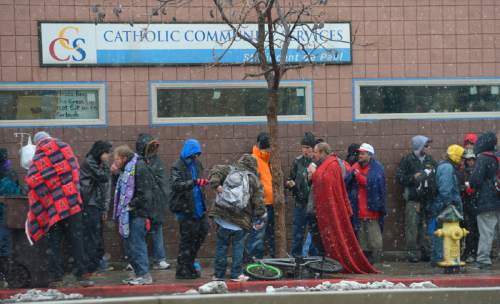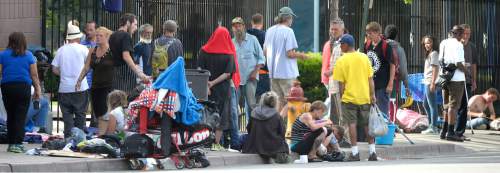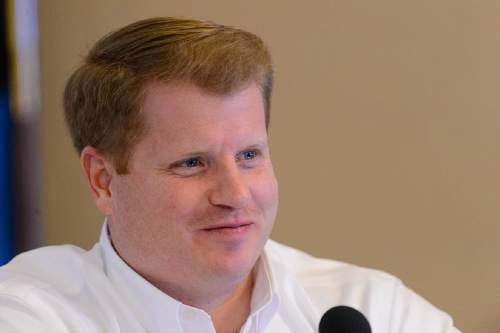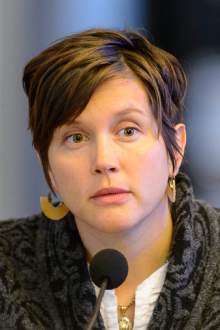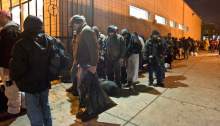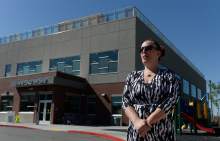This is an archived article that was published on sltrib.com in 2016, and information in the article may be outdated. It is provided only for personal research purposes and may not be reprinted.
The chaos and drug dealing surrounding The Road Home shelter on Rio Grande Street in downtown Salt Lake City may be coming to a neighborhood near you.
That is the fear voiced by some City Council members, who made known their anxieties recently regarding the proposal to build two new homeless shelters somewhere in the capital city.
Persuading a neighborhood to accept a shelter will be tough, warned council Chairman James Rogers. He pointed to the Inn Between, 344 S. Goshen St., a 25-bed hospice for homeless people that opened in 2015 and set off an avalanche of criticism in his west-side District 1.
If that was a hard sell, he warned, imagine something 10 times that size.
Mayor Jackie Biskupski countered that such alarm is misplaced and comes from a lack of information. The city will continue its public outreach to help residents better understand the proposals, she said. But, in the end, leaders must make tough decisions.
And time is running short.
The Mayor's Homeless Services Site Evaluation Commission, comprised of 30 people, proposed building two shelters that would house 250 to 300 individuals each, compared with the 1,000 or so now at the main shelter. The plan is aimed at reducing the homeless population on Rio Grande Street and would separate people according to subgroups in an effort to better coordinate services for them.
The Road Home's Midvale shelter can house up to 300 people. It is designed for families and is a peaceful world away from the tumult of Rio Grande Street.
Plans for the proposed facilities remain in the formative stages — but discussions point toward one of them being designated for single men and the other for women or unmarried couples.
Last week, the City Council met with Utah Jazz owner Gail Miller — who co-chairs the site selection commission with former Mayor Palmer DePaulis — and Biskupski. Afterward, Councilwoman Erin Mendenhall said she felt like the council was being left out of the conversation, particularly about the location of the proposed shelters. Mendenhall fears that unless a zone change is required for siting the new facilities, the council will not have voice in selecting the locations.
No locations have yet been selected, but Biskupski's staff now has the criteria for the sites assembled by the selection commission and is in the process of identifying parcels that meet those specifics, such as access to transportation and groceries.
Biskupski spokesman Matthew Rojas said the selection of the sites will be a collaborative effort. Nonetheless, the process remains vague on exactly who, ultimately, will make the decisions.
Rojas noted that the council also has a voice through Councilman Andrew Johnston, who sits on the selection commission.
When former Mayor Ralph Becker set up the commission in late 2014, he did not appoint any council members. When Biskupski took office earlier this year, she allowed one council member to join it.
Johnston said in the coming weeks, pieces of the shelter and services plan will come together, providing a clearer picture of the way forward.
Nonetheless, the new shelters will have a tremendous impact on the future of Salt Lake City, said Councilman Charlie Luke, particularly on the neighborhoods where they are located.
"It's critical that both the legislative and executive branches [of the city] have a role in the decision," he said. "I'm not saying we're being excluded, but I want a more active role."
Salt Lake County, which is analyzing how best to deliver services to the homeless population through its Collective Impact initiative, most likely will have something to say about site selection, too, Luke added.
"This is a unique situation," he said. "Three independent government agencies are trying to drive this: the state of Utah, the county and Salt Lake City."
Earlier this year, the Legislature allocated $7.9 million for additional shelters and a boost in services. A coalition, including homeless-services providers, as well as Salt Lake City and Salt Lake County, is seeking similar grants in 2017 and 2018. But to keep the funding coming, homeless advocates must show progress. And that means locations must be selected soon, DePaulis explained.
The former mayor hopes Biskupski will come back to the selection commission in August with a number of potential locations. At that point, DePaulis said, there will be collaboration among the commission, Biskupski, the City Council and the county. That would be followed by public hearings regarding the chosen locations.
"In the end, I think we will end up with something like the Midvale shelter," DePaulis said, "without drug dealing and chaos."


